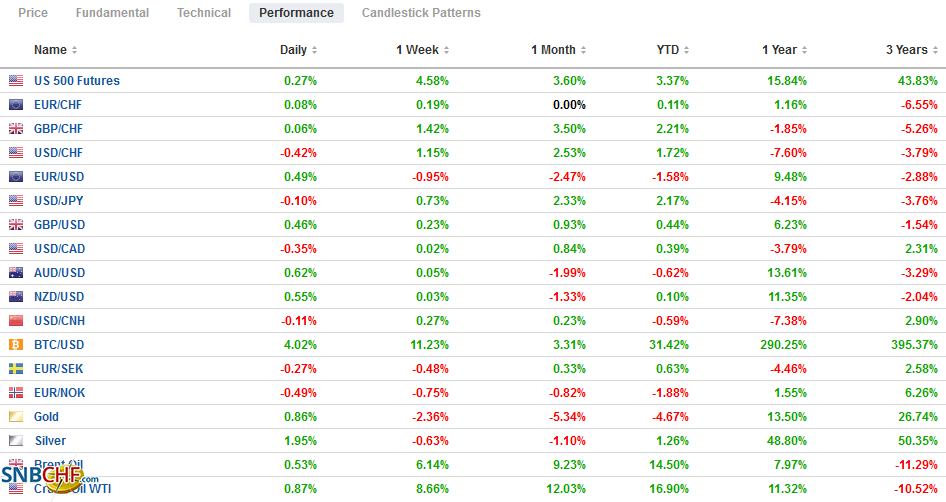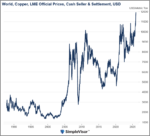Swiss FrancThe Euro has risen by 0.04% to 1.0821 |
EUR/CHF and USD/CHF, February 5(see more posts on EUR/CHF, USD/CHF, )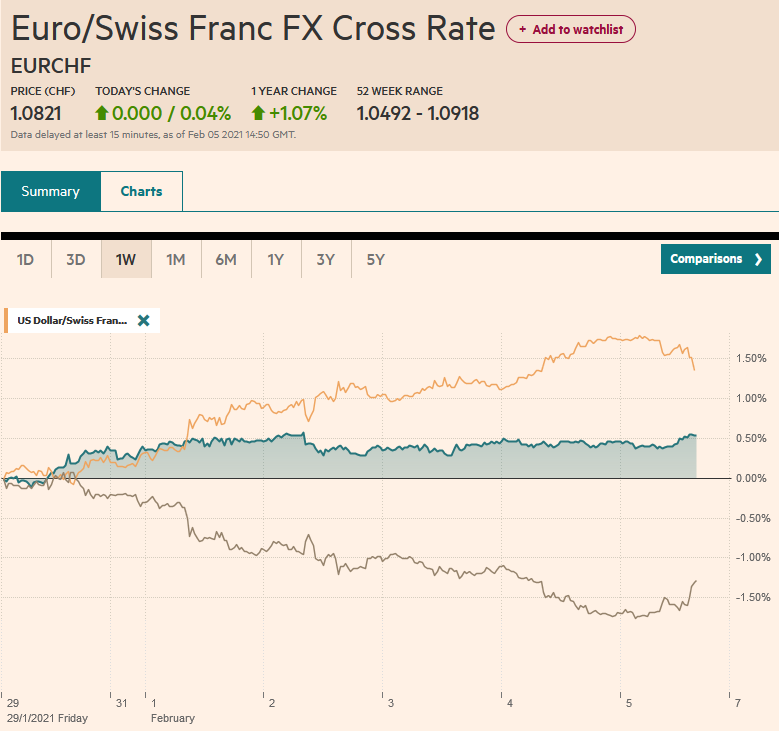 Source: markets.ft.com - Click to enlarge |
FX RatesOverview: While equities continue to march higher, the dollar is softer amid position squaring ahead of the US jobs data. Gold has stabilized after yesterday’s shellacking. Estimates for US nonfarm payrolls appear to have been creeping higher, encouraged by the ADP, PMI, and weekly initial jobless claims. A robust report today could bolster the dollar, as the short-term trading community still seems short. After the S&P 500 and NASDAQ made new record highs yesterday, Asia Pacific bourses, except for China, advanced. Japan, Australia, and South Korea’s main benchmarks rose by more than 1%. Europe’s Dow Jones Stoxx 600 is higher for the fifth consecutive session. The roughly 3.8% gain on the week would be the biggest since last November if sustained. US shares are firm. The bond market is quiet, with the US 10-year benchmark near 1.14%. The prospects of a Draghi-led Italian government have seen the Italian premium over German narrow, and it is now below 100 bp for the first time in five years. The greenback is lower against nearly all the currencies, major and emerging. The JP Morgan Emerging Market Currency Index is poised to snap a six-week decline. Gold fell to around $1785 yesterday, tumbling around 2.2%. It was squeezed back to about $1811 before stalling. Oil has moved in the opposite direction. It is up for a fifth consecutive session, leaving the March WTI contract around $57 a barrel. It is up nearly 9% this week and is above year-ago levels. |
FX Performance, February 5 |
Asia Pacific
Japan’s December household spending figures held in better than expected, falling 0.6%, a third of the decline that economists expected. Japan does not report Q4 20 GDP until February 15. An expansion of 2.0%-2.5% is expected after 5.3% quarter-over-quarter growth was reported in Q3. The household spending figures are consistent with a slowing in consumption from 5.1% in Q3.
Australia’s final look at December retail sales was in line with expectations, falling 4.1% (initially -4.2%). The new information is that excluding inflation, retail sales rose 2.5% in Q2 after a 6.5% increase in Q3. Separately, the RBA’s quarterly update warned that the rapid part of the recovery has passed and that going forward, growth is likely to be “uneven.” Of note, while many scenarios are holding out the promise of a stronger second half, the RBA expects the Australian economy to expand by 8% in the year through June before easing to a 3.5% pace. The central bank sees inflation accelerating to around 3% by mid-year–as some measures like free child care drop out—before being halved by the end of the year.
India had unveiled a bold initial earlier this week. However, with inflation near 4.6% in December, the central bank has little room to maneuver. It left the repo rate at 4.0% and the reverse repo at 3.35%, as widely expected. The 10-year Indian bond yield is up more than 20 bp this week to 6.10%. The rupee is flat against the dollar this week (~+0.0.4%), making it one of the few in the region that did not succumb to the rebounding greenback.
The dollar traded above its 200-day moving average (~JPY105.60) against the yen since last June, culminating a seven-day rally, encouraged by the five-day rise in the US Treasury yields. A pullback in late Asia saw the greenback ease to about JPY105.35, where Europe bought it again. The next target is the JPY106.00-JPY106.10 area. The Australian dollar is straddling the $0.7600-area as it has done all week. It fell to about $0.7565 on February 2 and has been in the range set on the day (~$0.7565-$0.7660). The downside momentum has faded, and of the major currencies we track, it could be the first to signal a coming bounce after trending lower for a month. The dollar’s reference rate was set at CNY6.4710 by the PBOC, a little firmer than the models suggested. The money market has stabilized, and the PBOC was a net provider of funds this week. The dollar is up about 0.65% against the yuan this week, the most since the end of September. It remains within the range set on the first two trading sessions of the year (~CNY6.43-CNY6.5150).
Europe
Conte’s failure to form a new government in Italy has not been the political crisis that many feared. As the country did during the sovereign crisis s a decade ago, it turned to a non-political leader to have navigated the country through the multidimensional crisis now. Eurosystem buying undoubtedly helped the Italian 10-year yield fall around nine basis points this week to a new record low just above 50 bp, and premium over Germany has fallen below 100 bp for the first time five years. Other peripheral yields in Europe have edged higher this week. A vote of confidence could be held as early as next week, according to reports. A key issue is whether Draghi tried to form a government with technocrats or politicians. The Five Star Movement is opposed, even though early elections would likely see it lose seats. Its support has waned, but this principled stance and arguments about the “undemocratic” nature of Draghi-led government may bolster its ranks.
Germany’s December factory orders disappointed, falling nearly twice the 1% decline that economists expected. The upward revision to the November series (2.7% from 2.3%) offered little consolation as it merely makes the drop more dramatic. There is not always a tight fit between orders and output, but the market was already anticipating a soft industrial production report at the start of next week. After rising by 0.9% in November, Bloomberg’s survey median forecast sees a 0.1% gain.
The Bank of England revised down its 2021 GDP forecast and warned of a rapid pick-up from the rapid deployment of the vaccine. One report suggested that it took about 45 days for the UK to vaccinate 10% of its population and less than two more weeks to reach 20%. Despite urging banks to prepare for possible negative rates, the Bank of England Governor seemed to persuade the market that the UK may be at its peak monetary efforts. The short-sterling futures strip no longer implies negative rates. Moreover, the negative rates are being pushed out of the coupon curve, beginning with the three and five-year Gilts. The one and two-year bonds still have slightly negative yields.
The euro’s drop continued to almost $1.1950 today, roughly four cents from the high seen a month ago. It has steadied but unable to resurface above $1.20, where an option for 1.1 bln euro will expire later today. Another one for 1 bln struck at the same place expires on Monday. On the downside, the next important retracement objective is near $1.1875. The shifting rate expectations appear to be helping sterling maintain its recent resilience. It rebounded smartly from the drop to around $1.3565 yesterday, a nearly three-week low. The upper end of the range is in the $1.3760 area. Sterling is also deriving support from the cross against the euro. The euro posted a big outside down day yesterday as it broke below GBP0.8800 for the first time since last May. The next area of support is seen around GBP0.8670-GBP0.8700.
America
Canada and the US report January jobs figures today. Canada lost 3 mln jobs as the pandemic struck and has recouped about 2.34 mln or nearly 78%. The US lost roughly 22 mln jobs and has recouped around 12.3 mln or approximately 56%. Canada lost almost 53k jobs in December and is expected to have shed another 40k. However, the underlying detail is important: the jobs lost in December were all part-time positions (95k). Canada actually grew about 43k full-time positions in December. The US lost an unexpected 140k jobs in December, but several reports, including ADP and the PMI, have spurred economists to revise up their estimates for today’s report. Some are talking about as much as a 200k gain in non-farm payrolls.
| The US also reports December trade figures, which could impact economists’ expectations for Q4 GDP revisions. In the first 11 months of 2020, the US recorded a trade deficit of nearly $605 bln. In the same period in 2018 and 2019, the US trade deficits of $531.2 bln and $523.5 bln, respectively, were reported. |
U.S. Manufacturing Payrolls, January 2021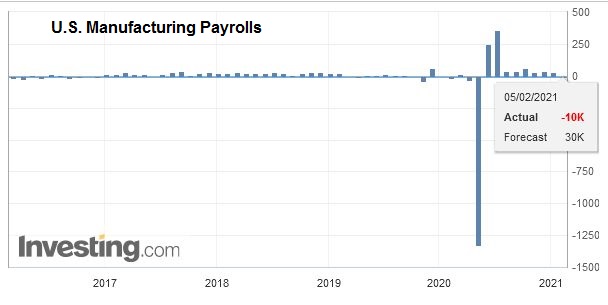 Source: investing.com - Click to enlarge |
| We argue that all else being equal, the growth differentials that favor the US and are fueled to a large degree by fiscal stimulus will generate a larger trade shortfall. Although we have anticipated this dollar bounce and suspect it may not be over, the twin-deficit issue is critical to our underlying bearishness. |
U.S. Nonfarm Payrolls, January 2021(see more posts on U.S. Nonfarm Payrolls, )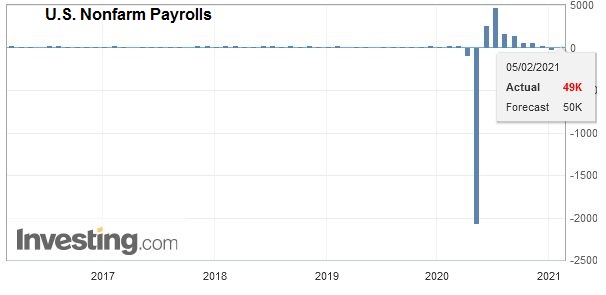 Source: investing.com - Click to enlarge |
| Separately, the US December consumer credit figures will be released today. They are not typically market movers. However, it may offer insight into the economy’s recovery. March through May last year saw consumer credit growth reverse. It fell by $95 bln. |
U.S. Average Weekly Hours, January 2021(see more posts on U.S. Average Weekly Hours, )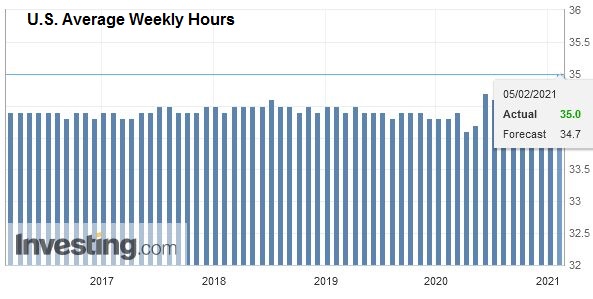 Source: investing.com - Click to enlarge |
| Subsequently, it has risen by $58 bln. Consumer credit is expected to have increased by $12 bln in December. Such an increase would mean that for the year as a whole, consumer credit grew slightly. |
U.S. Participation Rate, January 2021(see more posts on U.S. Participation Rate, )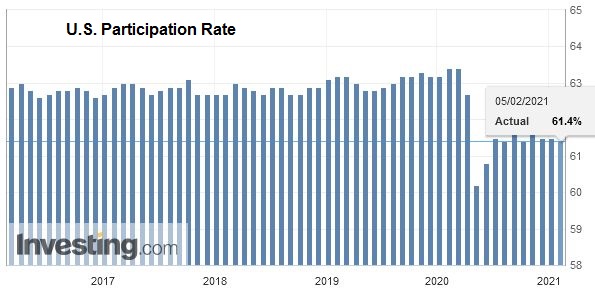 Source: investing.com - Click to enlarge |
The US dollar has been confined to the range set last Friday against the Canadian dollar (~CAD1.2735-CAD1.2875) all week. Within that range, the greenback has found support in the CAD1.2760-CAD1.2780 and struggles in the CAD1.2840-CAD1.2860 area. Rising equities (risk-on) and rising oil (a proxy for commodities) have underpinned the Canadian dollar, which is the be performing major currency against the dollar this week, losing less than 0.2% (around CAD1.28). The greenback has moved into a higher range against the Mexican peso. It had been mostly MXN19.50-MXN20.00. For the better part of the past two weeks, a new range has emerged: MXN20.00-MXN20.50. That said, like its performance against the Canadian dollar, the greenback has mostly been confined to last Friday’s range (~MXN20.0850-MXN20.60). Note that Banixco meets next week and is expected to deliver a 25 bp rate cut.
Graphs and additional information on Swiss Franc by the snbchf team.
Full story here Are you the author? Previous post See more for Next postTags: #USD,Currency Movement,Featured,India,Italy,jobs,negative rates,newsletter,Trade,U.K.










